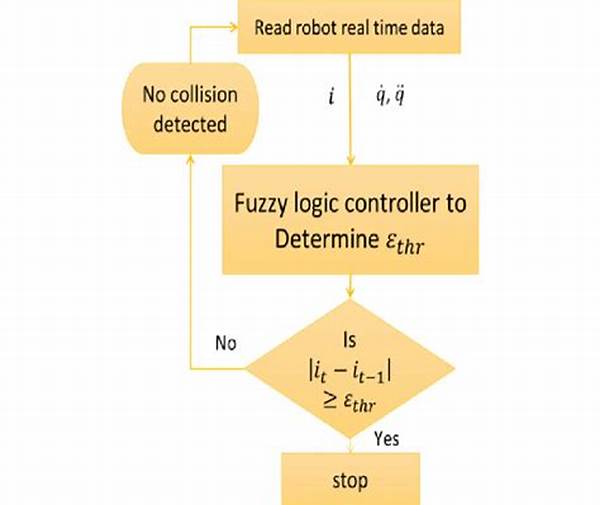Hey there, tech enthusiasts! Today, we’re diving into the dynamic world of real-time collision detection algorithms. If you’re a gamer, work in simulation, or just someone who’s stumbled upon this corner of the internet, you’re in for a treat. These algorithms are the unsung heroes behind the scenes, ensuring that when virtual objects meet, they interact just like they would in the real world. So, let’s unpack this fascinating topic together.
Read Now : Parallel Processing Techniques In Physics
Understanding Real-Time Collision Detection Algorithms
Real-time collision detection algorithms work tirelessly to keep our digital worlds in check. Imagine a high-speed car chase in an action game or a spaceship navigating an asteroid belt in a simulation—the last thing we want is for these objects to pass through each other like ghosts. These algorithms calculate and predict collisions on the fly, making sure that every bump, crash, or gentle tap feels authentic.
Behind the curtain, there’s a lot of complex math and physics, but don’t let that scare you. Essentially, these algorithms perform rapid calculations to detect intersections or interactions between various virtual objects. By doing this efficiently in real-time, they maintain the illusion of reality, providing seamless experiences whether you’re saving a princess or exploring alien worlds. Without real-time collision detection algorithms, your latest gaming escapade would just become a pixelated mess of chaos and mayhem!
In practical terms, these algorithms enhance user experience by preventing glitches and anomalies. Developers often use techniques like bounding volumes, spatial partitioning, and continuous collision detection to achieve their goals. Whether you’re picking up a simple 2D retro game or venturing into a cutting-edge VR simulation, real-time collision detection algorithms are right there, working tirelessly to make your interaction as engaging and believable as possible.
The Role of Physics in Real-Time Collision Detection
Physics is the beating heart of real-time collision detection algorithms. It ensures that virtual objects behave naturally when they collide. By simulating real-world physics, these algorithms make it possible for developers to create visually stunning and highly interactive experiences.
Intersections are all about timing, and real-time collision detection algorithms nail this perfectly. They calculate whether objects will collide and, if so, figure out when and where. This ensures a smooth and realistic interaction, keeping users immersed in the digital experience.
Memory efficiency is vital when employing real-time collision detection algorithms. By optimizing resource use, developers ensure that even complex scenes run smoothly without burdening the system. This balance between performance and accuracy is key to success.
Cutting-edge techniques redefine what’s possible with real-time collision detection algorithms. Developers employ various methods, such as ray casting and spatial partitioning, to push the boundaries of performance and realism.
Adaptability is a crucial asset for real-time collision detection algorithms. As new hardware becomes available, these algorithms evolve to leverage improved computing power, ensuring they’re always ready to meet modern gaming needs.
Challenges in Implementing Real-Time Collision Detection
Implementing real-time collision detection algorithms isn’t all sunshine and rainbows—it comes with its fair share of challenges. The main hurdle? Ensuring the process is as fast as lightning while maintaining accuracy. Every millisecond counts, and even slight delays can tarnish the user experience. So, how do developers tackle this?
They get crafty with optimizations. Algorithms like bounding volume hierarchies and spatial hashing help streamline collision checks by reducing the number of necessary calculations. These are the secret weapons in the developer’s arsenal, providing the perfect balance between speed and precision.
Scalability is another concern. As games and simulations become more intricate, real-time collision detection algorithms must be able to keep up with the increased complexity. This requires constant tweaking, testing, and sometimes inventing new approaches altogether. Despite the obstacles, these challenges drive innovation in the industry, leading to better and more engaging experiences for users.
Tools and Techniques in Real-Time Collision Detection
Bounding volumes provide a simplistic way to approximate objects for quick collision checks. By using shapes like spheres or boxes, developers can quickly rule out objects unlikely to intersect, optimizing real-time collision detection algorithms.
Spatial partitioning breaks up the game world into manageable sections. This method helps limit collision checks only to relevant areas, making real-time collision detection algorithms more efficient and ensuring smoother gameplay experiences.
Ray casting sends out invisible lines to detect intersections and surfaces. This technique is particularly useful in scenarios where only certain interactions matter, saving resources and enhancing real-time collision detection algorithms’ performance.
Read Now : Advanced Sprite Layer Controls
Continuous collision detection is a more precise method that predicts future states of objects, ensuring accurate collision handling. This technique prevents fast-moving objects from skipping collisions, keeping interactions realistic within real-time collision detection algorithms.
Parallel processing is all about leveraging modern multi-core systems. By spreading out tasks across different cores, real-time collision detection algorithms can handle more information simultaneously, resulting in smoother and more comprehensive performance.
Geometry simplification involves reducing the complexity of an object’s shape without sacrificing too much detail. This approach helps lighten the load on real-time collision detection algorithms, facilitating faster processing and allowing for greater scalability.
Importance of Real-Time Collision Detection Algorithms
The significance of real-time collision detection algorithms cannot be overstated, especially in today’s fast-evolving digital landscape. For starters, these algorithms are the backbone of any interactive experience. From video games to VR simulations, they ensure that objects in a virtual environment interact realistically and consistently, adding that crucial layer of immersion that users crave.
One of the most exciting aspects of real-time collision detection algorithms is their ability to bring complex physics-based scenarios to life. Picture a game where debris flies realistically after an explosion or a simulator that accurately replicates car physics in a race. Such scenarios are achievable because these algorithms enable real-time processing of multiple object interactions, synchronizing them within the tight framerate demands of modern applications.
Moreover, real-time collision detection algorithms play a crucial role in performance optimization. By minimizing unnecessary computations, they help maintain high FPS (frames per second), ensuring that the user experience remains fluid and responsive. Thanks to various clever techniques, like spatial partitioning and bounding volume hierarchies, developers can create expansive worlds full of dynamic interactions without sacrificing performance.
Adapting Real-Time Collision Detection for the Future
As we leap into the future, real-time collision detection algorithms are set to evolve even further. Imagine harnessing the power of AI to predict and anticipate potential collisions even more accurately. This innovation could lead to smarter, more efficient algorithms that adapt to changes in the environment, paving the way for new and exciting possibilities in gaming and simulations.
The integration of machine learning techniques could also redefine how we approach real-time collision detection algorithms. Imagine an algorithm that learns from past interactions, adapting to better handle specific scenarios with each iteration. This could result in more accurate and context-aware collision detection, making virtual experiences even more lifelike.
Finally, let’s not forget the potential for cross-industry applications. From autonomous vehicles to robotics and even architectural simulations, the insights gained from perfecting real-time collision detection algorithms in gaming could readily apply to these fields. As technology continues to advance, we can expect these algorithms to become an integral part of many different industries.
Wrapping Up Our Exploration
In summary, real-time collision detection algorithms are the unsung champions of the tech world, enhancing immersive experiences and maintaining the seamless interaction of virtual objects. Whether it’s a high-octane racing game or a detailed VR simulation, these algorithms ensure everything works without a hitch. Developers tap into complex mathematical concepts and innovative strategies to ensure accuracy without sacrificing performance.
By addressing various challenges, leveraging tools and techniques, and anticipating future advancements, the industry is poised for continued growth and innovation. As new technologies emerge, we can’t wait to see how real-time collision detection algorithms will adapt and transform, unlocking even more marvelous digital experiences. Whether you’re a developer, a gamer, or just a curious passerby, understanding these algorithms is a delightful way to appreciate the magic behind our favorite digital worlds.





